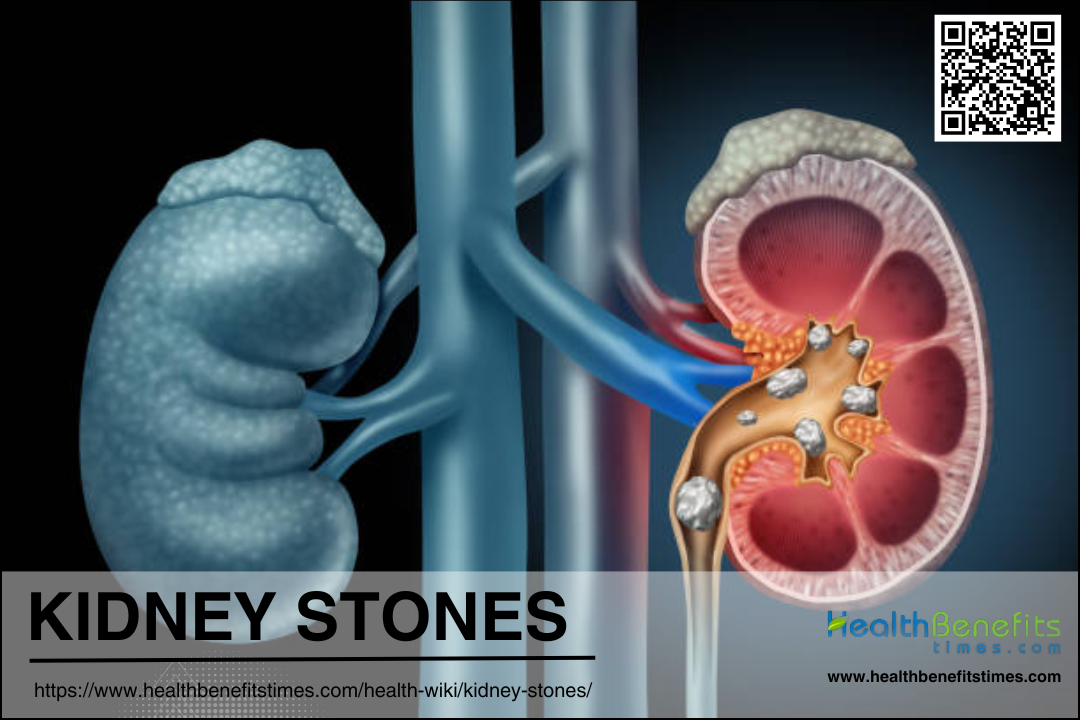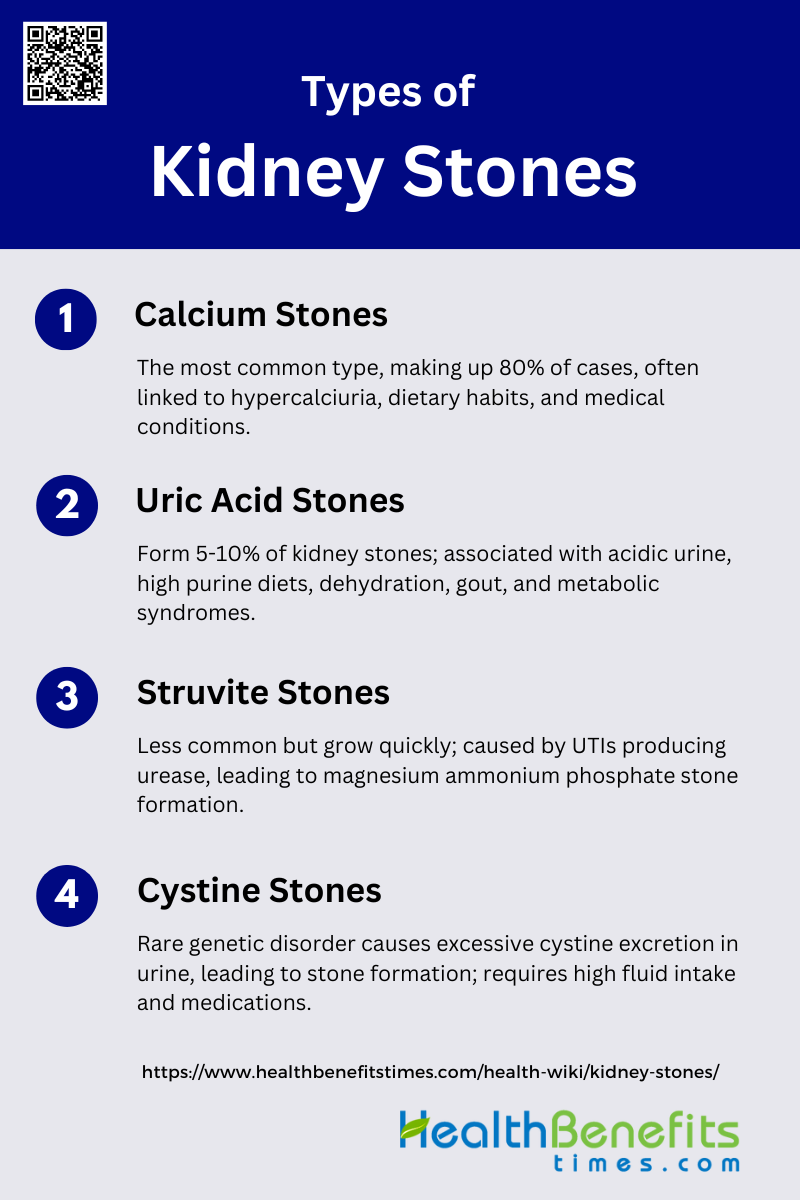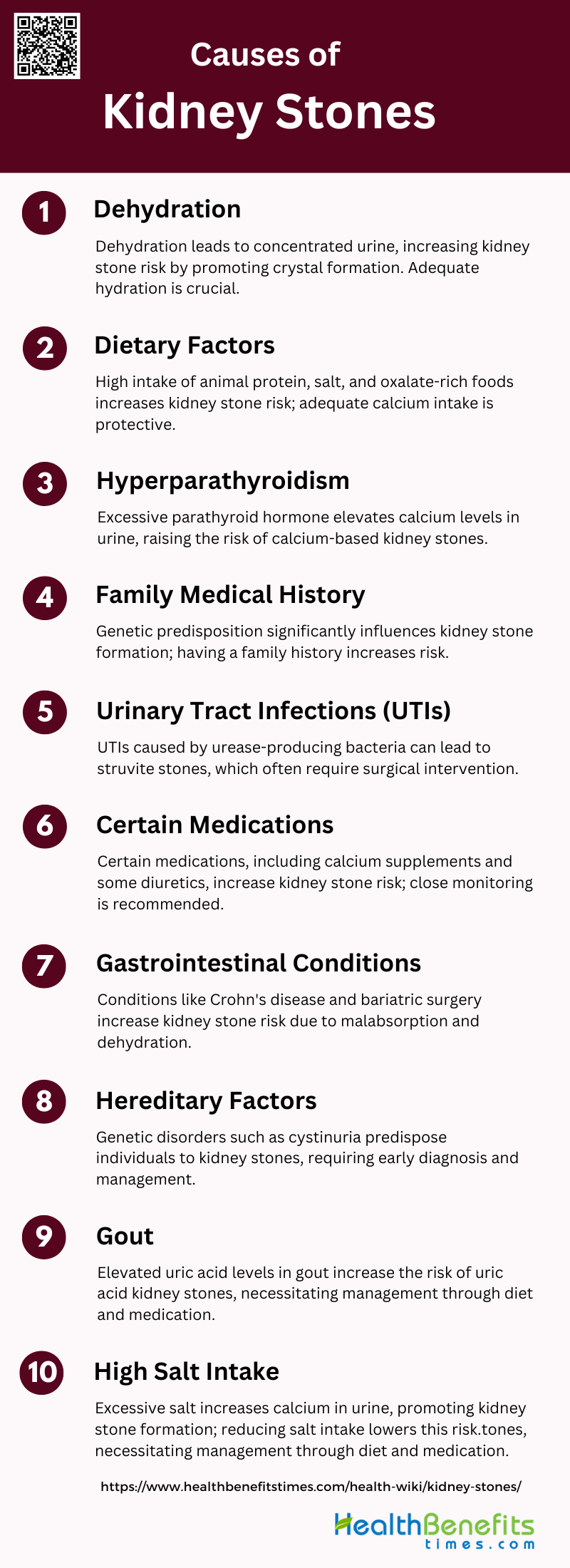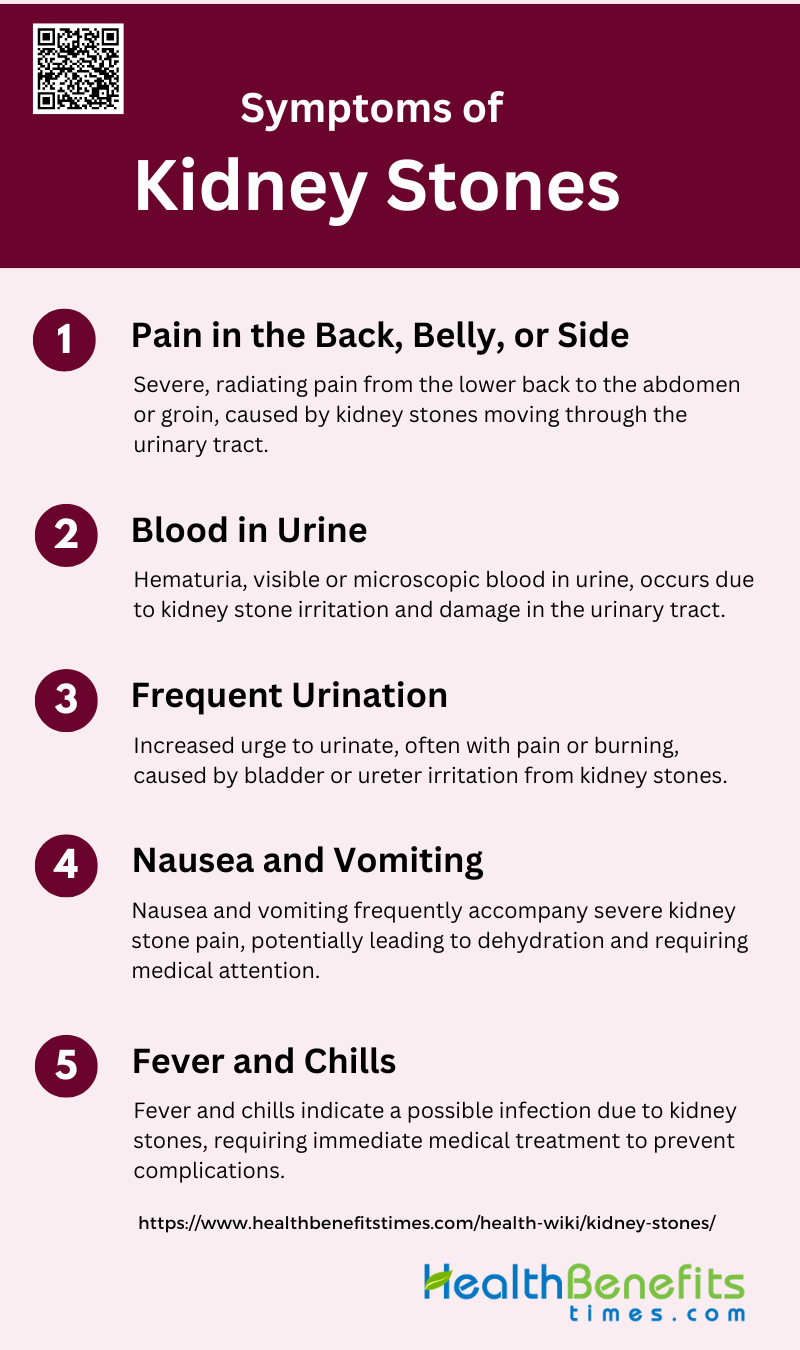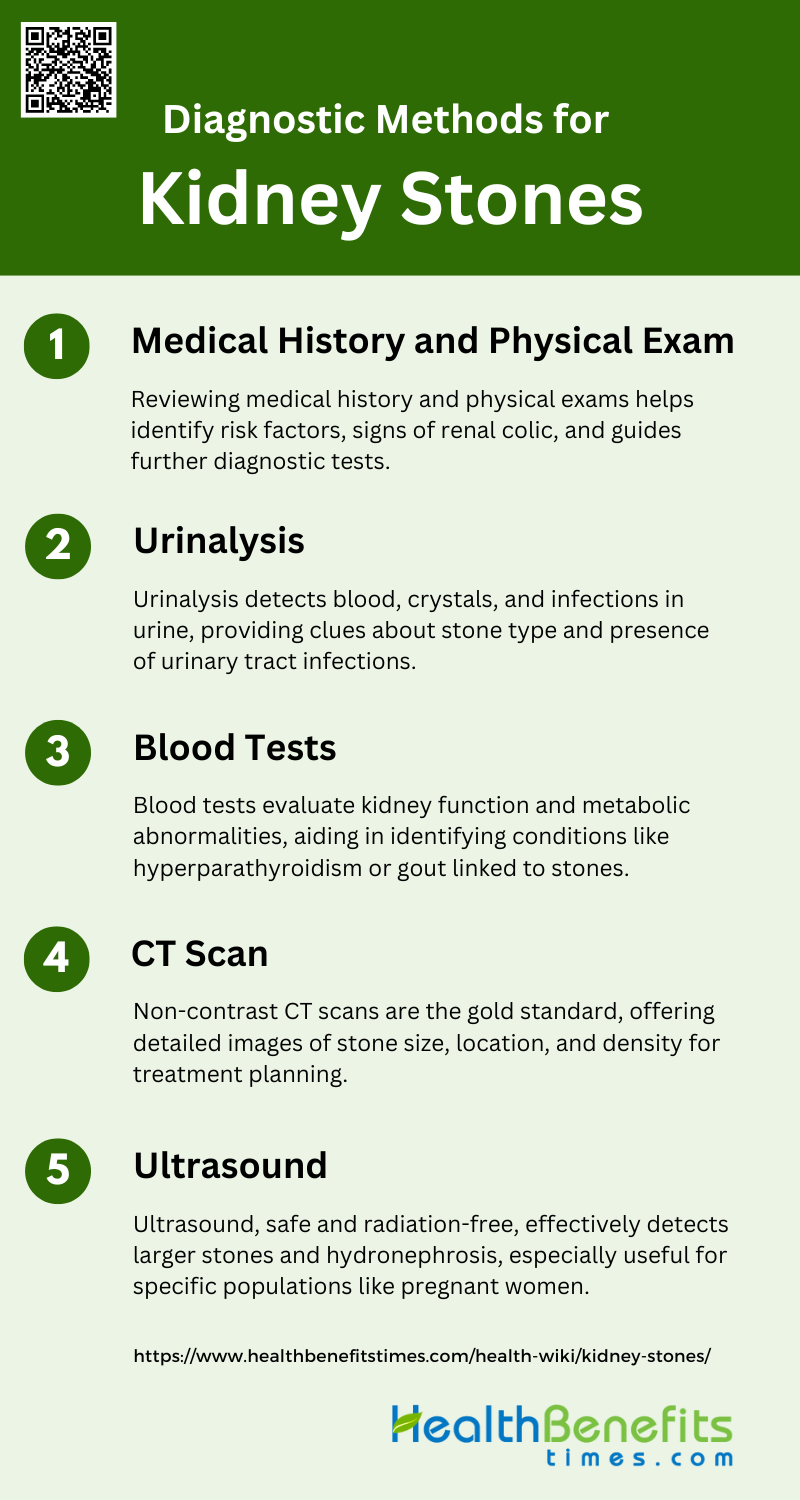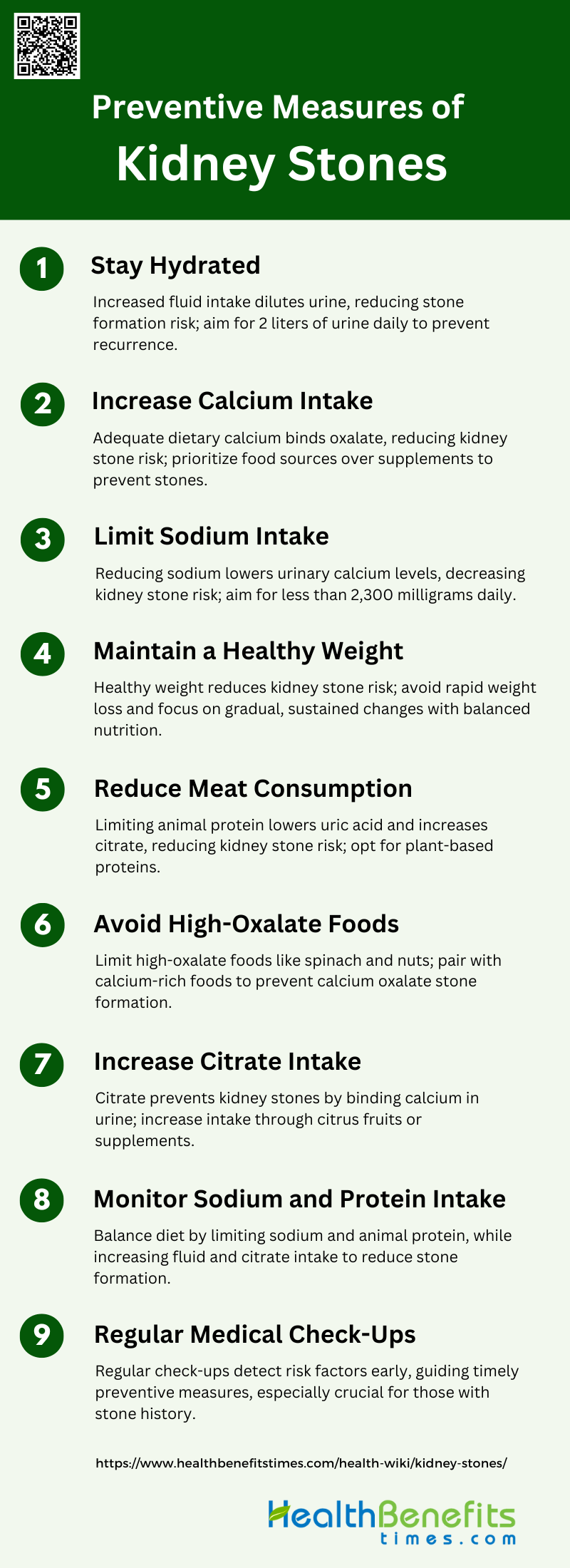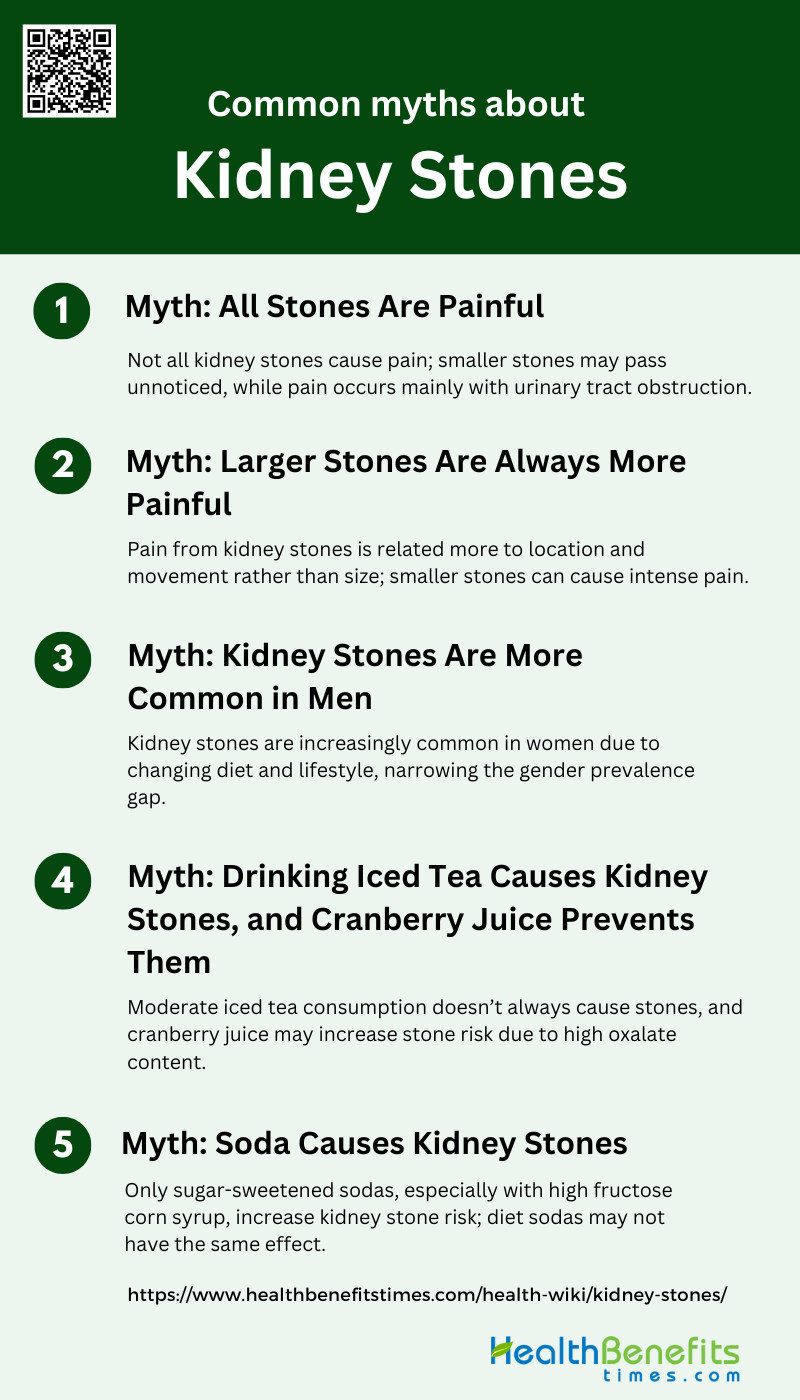Kidney stones, also known as renal stones or urinary stones, are small, hard deposits that form in one or both kidneys from minerals or other compounds found in urine. These stones can vary significantly in size, shape, and color. To be expelled from the body, kidney stones must travel through the ureters, which are ducts that carry urine from the kidneys to the bladder, and then be excreted. The process of passing a kidney stone can take anywhere from days to weeks, depending on the stone’s size. The formation of kidney stones is influenced by a combination of metabolic and environmental factors, and they are associated with various systemic disorders such as chronic kidney disease, hypertension, and type 2 diabetes mellitus.
How kidney stones form?
Kidney stones are hard deposits formed from minerals and other compounds found in urine. The formation of kidney stones is a multifactorial process involving several physicochemical events such as supersaturation, nucleation, growth, aggregation, and retention of urinary stone constituents within the renal tubular cells. The most common type of kidney stone is composed of calcium oxalate, which often forms at Randall’s plaque on the renal papillary surfaces. Urinary supersaturation and crystallization are the driving forces behind intrarenal crystal precipitation, with calcium oxalate and calcium phosphate being the predominant minerals involved. Reactive oxygen species and oxidative stress also play a significant role in the formation and growth of these plaques, leading to inflammation and cellular injury. Additionally, the microbiome, including urease-producing bacteria, and the immune response, particularly macrophage differentiation, are crucial in the development of nephrolithiasis. Understanding these mechanisms is essential for developing new therapeutic strategies to manage and prevent kidney stone formation.
Types of Kidney Stones
Kidney stones come in various types, each with distinct causes and characteristics. Understanding these types is crucial for effective prevention and treatment. Here are the main types of kidney stones:
1. Calcium Stones
Calcium stones are the most common type of kidney stones, making up about 80% of cases. These stones are primarily composed of calcium oxalate, although they can also contain calcium phosphate. The formation of calcium stones is often linked to high levels of calcium in the urine, a condition known as hypercalciuria. Factors contributing to the development of calcium stones include dietary habits, such as high salt and protein intake, and certain medical conditions like hyperparathyroidism and renal tubular acidosis. Additionally, genetic predispositions and metabolic disorders can increase the risk of calcium stone formation.
2. Uric Acid Stones
Uric acid stones account for approximately 5-10% of all kidney stones. They form when urine is persistently acidic, which can lead to the crystallization of uric acid. This type of stone is often associated with a diet high in purines, found in foods like red meat, shellfish, and certain fish, which increase uric acid levels in the body. Other contributing factors include dehydration, which concentrates the urine, and conditions such as gout and certain metabolic syndromes. Individuals with a family history of uric acid stones or those who have undergone chemotherapy may also be at higher risk.
3. Struvite Stones
Struvite stones, also known as infection stones, are less common but can grow quickly and become quite large. They are composed of magnesium ammonium phosphate and typically form in response to a urinary tract infection (UTI) caused by bacteria that produce urease. This enzyme breaks down urea into ammonia, which alkalizes the urine and promotes the formation of struvite crystals. Women are more prone to struvite stones due to a higher incidence of UTIs. Contributing factors include chronic UTIs, certain neurological disorders that affect bladder function, and long-term use of catheters.
4. Cystine Stones
Cystine stones are rare and result from a genetic disorder called cystinuria, which causes the kidneys to excrete excessive amounts of the amino acid cystine into the urine. Cystine is poorly soluble in urine, leading to the formation of crystals and stones. This condition is inherited in an autosomal recessive pattern, meaning both parents must carry the gene for the disorder to manifest in their offspring. Individuals with cystinuria often experience recurrent kidney stones from a young age. Preventive measures include maintaining high fluid intake and using medications to reduce cystine levels in the urine.
Causes of Kidney Stones
Kidney stones develop due to a combination of dietary, lifestyle, and genetic factors that lead to the formation of crystals in the kidneys. Understanding these causes is essential for effective prevention and management. Here are the primary causes of kidney stones:
1. Dehydration
Dehydration is a significant risk factor for kidney stone formation. When the body is dehydrated, urine becomes more concentrated, leading to higher levels of stone-forming substances such as calcium, oxalate, and uric acid. This increased concentration can facilitate the crystallization process, resulting in kidney stones. Individuals who sweat excessively, such as athletes or those living in hot climates, are particularly susceptible due to reduced urine volume. Studies have shown that increased fluid intake can dilute urine and decrease the risk of stone formation, making hydration a crucial preventive measure.
2. Dietary Factors
Diet plays a crucial role in the formation of kidney stones. High intake of animal protein, salt, and oxalate-rich foods can increase the risk of stone formation. Animal protein increases calcium and uric acid excretion, while high salt intake reduces calcium reabsorption in the kidneys, leading to higher calcium levels in the urine. Oxalate-rich foods like spinach and nuts can also contribute to stone formation. Conversely, adequate dietary calcium can help by binding oxalate in the gut, reducing its absorption and subsequent excretion in the urine.
3. Hyperparathyroidism
Hyperparathyroidism is a condition characterized by excessive production of parathyroid hormone (PTH), which regulates calcium levels in the blood. Elevated PTH levels lead to increased calcium release from bones, increased calcium absorption from the gut, and increased calcium reabsorption in the kidneys. This results in hypercalciuria, a condition where high levels of calcium are excreted in the urine, significantly increasing the risk of calcium-based kidney stones. Effective management of hyperparathyroidism is essential to reduce the risk of recurrent kidney stones.
4. Family Medical History
A family history of kidney stones is a well-documented risk factor. Genetic predisposition plays a significant role, with studies indicating that more than 50% of patients with kidney stones have a first-degree relative who also suffers from the condition. Genetic factors can influence various metabolic processes, such as calcium and oxalate metabolism, making individuals more susceptible to stone formation. Twin studies have shown that the stone formation rate is higher in monozygotic twins compared to dizygotic twins, further emphasizing the genetic link.
5. Urinary Tract Infections (UTIs)
Urinary tract infections (UTIs), particularly those caused by urease-producing bacteria like Proteus species, can lead to the formation of struvite stones. These bacteria produce an enzyme called urease, which breaks down urea into ammonia, increasing the urine pH and promoting the crystallization of magnesium ammonium phosphate (struvite). Struvite stones can grow rapidly and become quite large, often requiring surgical intervention. Preventing and promptly treating UTIs is crucial in reducing the risk of struvite stone formation.
6. Certain Medications
Certain medications can contribute to kidney stone formation. For example, calcium supplements, high-dose vitamin C, and poorly soluble drugs like triamterene and felbamate can increase the risk. Carbonic anhydrase inhibitors, such as acetazolamide and topiramate, can also cause stones by increasing urine pH and decreasing citrate excretion. Patients on these medications should be monitored closely, and alternative treatments should be considered if they are at high risk for kidney stones.
7. Gastrointestinal Conditions
Gastrointestinal conditions such as inflammatory bowel disease, Crohn’s disease, and bariatric surgery can increase the risk of kidney stones. These conditions often lead to malabsorption, resulting in higher levels of oxalate in the urine (hyperoxaluria). Additionally, chronic diarrhea can cause dehydration and low urine volume, further increasing the risk. Managing these gastrointestinal conditions effectively and ensuring adequate hydration can help reduce the risk of stone formation.
8. Hereditary Factors
Hereditary factors play a significant role in kidney stone formation. Conditions like cystinuria, primary hyperoxaluria, and Dent’s disease are genetic disorders that predispose individuals to stone formation. These conditions affect the metabolism of specific substances, leading to their increased excretion in the urine and subsequent crystallization. Genetic counseling and early diagnosis are essential for managing these hereditary conditions and preventing recurrent kidney stones.
9. Gout
Gout is a metabolic disorder characterized by elevated levels of uric acid in the blood, which can lead to the formation of uric acid stones. Individuals with gout are at a higher risk of developing kidney stones due to the increased excretion of uric acid in the urine. Managing gout through medications that lower uric acid levels and dietary modifications can help reduce the risk of uric acid stone formation. Regular monitoring of uric acid levels is also recommended for individuals with a history of gout.
10. High Salt Intake
High salt intake is a significant dietary risk factor for kidney stones. Excessive salt consumption increases calcium excretion in the urine, which can lead to the formation of calcium-based stones. Reducing salt intake can help lower urinary calcium levels and decrease the risk of stone formation. Dietary recommendations for individuals at risk of kidney stones often include limiting salt intake to reduce the burden on the kidneys and prevent stone recurrence.
Symptoms of Kidney stones
Kidney stones can cause a range of symptoms that vary in intensity and duration. Recognizing these symptoms early can help in seeking timely medical intervention. Here are some common signs to watch out for:
1. Pain in the Back, Belly, or Side
Kidney stones often cause severe pain in the back, belly, or side, a condition known as renal colic. This pain is typically excruciating and can radiate from the lower back to the abdomen and groin. The pain is caused by the stone moving through the urinary tract, which can lead to spasms in the ureter. This type of pain is often described as one of the most intense forms of pain, comparable to childbirth contractions. The pain usually comes in waves, lasting from 20 to 60 minutes, and can be accompanied by other symptoms such as nausea and vomiting.
2. Blood in Urine
The presence of blood in the urine, known as hematuria, is a common symptom of kidney stones. This occurs because the stone can cause irritation and damage to the lining of the urinary tract as it moves through it. Hematuria can be either macroscopic, where the blood is visible to the naked eye, or microscopic, where the blood is only detectable under a microscope. The severity of hematuria can vary, but it is often one of the first signs that prompt individuals to seek medical attention. In some cases, the blood in the urine may be accompanied by pus, indicating a possible infection.
3. Frequent Urination
Frequent urination is another symptom associated with kidney stones. This occurs because the stone can irritate the bladder or the ureter, leading to an increased urge to urinate. Patients may feel the need to urinate more often than usual, and this can be accompanied by a burning sensation or pain during urination. In some cases, the frequent urge to urinate can be so intense that it disrupts daily activities and sleep. This symptom is particularly common when the stone is located near the bladder.
4. Nausea and Vomiting
Nausea and vomiting are common symptoms that often accompany the pain caused by kidney stones. These symptoms are thought to be a result of the body’s response to the severe pain and the irritation of the gastrointestinal tract by the stone. The nausea and vomiting can be severe enough to require medical intervention, such as the administration of antiemetic medications. These symptoms can also lead to dehydration, which can further complicate the condition and make it more difficult for the stone to pass naturally.
5. Fever and Chills
Fever and chills can occur if a kidney stone leads to an infection in the urinary tract. This is a serious complication that requires immediate medical attention. The infection can cause systemic symptoms such as a high fever, chills, and an overall feeling of being unwell. In severe cases, the infection can spread to the kidneys, leading to a condition known as pyelonephritis, which can be life-threatening if not treated promptly. The presence of fever and chills, along with other symptoms like flank pain and nausea, often indicates that the infection has become severe.
Diagnostic Methods for Kidney Stones
Identifying kidney stones involves a variety of diagnostic techniques to determine their size, location, and composition. Early and accurate diagnosis is crucial for effective treatment. Here are some common methods used to diagnose kidney stones:
1. Medical History and Physical Exam
Medical history and physical examination are fundamental steps in diagnosing kidney stones. A thorough medical history can reveal risk factors such as family history, dietary habits, and previous occurrences of kidney stones. Physical examination often focuses on identifying signs of renal colic, which is characterized by severe, intermittent pain radiating from the flank to the groin. This pain is typically associated with ureteral stones causing obstruction. Additionally, physical exams may reveal tenderness in the costovertebral angle, which is indicative of kidney involvement. These initial steps are crucial for guiding further diagnostic testing and management strategies.
2. Urinalysis
Urinalysis is a critical diagnostic tool for kidney stones, providing valuable information about the presence of hematuria, crystalluria, and infection. Hematuria, or blood in the urine, is a common finding in patients with kidney stones. Crystalluria can indicate the type of stones, such as calcium oxalate or uric acid stones. A 24-hour urine collection may be performed to assess the excretion of stone-forming substances like calcium, oxalate, and uric acid. Urinalysis also helps in identifying urinary tract infections, which can complicate the clinical picture and require additional treatment.
3. Blood Tests
Blood tests are essential in the diagnostic workup of kidney stones to evaluate renal function and identify metabolic abnormalities. Common tests include serum creatinine to assess kidney function, and levels of calcium, uric acid, and phosphorus to detect metabolic conditions that predispose to stone formation. Elevated calcium levels may suggest hyperparathyroidism, while high uric acid levels can indicate gout or a predisposition to uric acid stones. These tests help in tailoring specific treatments and preventive measures for patients with kidney stones.
4. CT Scan
Computed tomography (CT) scans, particularly non-contrast CT, are considered the gold standard for diagnosing kidney stones due to their high sensitivity and specificity. CT scans provide detailed images that help in determining the size, location, and density of stones, which are crucial for treatment planning. Low-dose CT protocols have been developed to minimize radiation exposure while maintaining diagnostic accuracy. Despite the radiation risk, CT scans are invaluable in acute settings for rapid and accurate diagnosis, especially when other imaging modalities yield inconclusive results.
5. Ultrasound
Ultrasound is a preferred initial imaging modality for kidney stones, especially in specific populations like pregnant women and children, due to its safety and lack of radiation exposure. While ultrasound may have lower sensitivity and specificity compared to CT, it is effective in detecting larger stones and hydronephrosis, which indicates obstruction. Ultrasound is also useful for follow-up evaluations to monitor stone progression or resolution. In emergency settings, point-of-care ultrasound can provide quick and valuable information, guiding immediate management decisions.
Treatment Options for Kidney Stones
Treating kidney stones depends on their size, type, and severity of symptoms. Various methods are available to alleviate pain, remove stones, and prevent recurrence. Here are some common treatment options for kidney stones:
1. Drinking sufficient Water
Drinking sufficient water is a fundamental and non-invasive approach to managing kidney stones. Adequate hydration helps to dilute the substances in urine that lead to stones, thereby reducing the risk of stone formation. Increased fluid intake can also aid in the passage of small stones by increasing urine output, which helps to flush out the urinary tract. This method is particularly effective for preventing the recurrence of stones and is often recommended as a first-line preventive measure. While it may not be sufficient for larger stones, it is a crucial component of overall kidney health and stone management.
2. Pain relief medications
Pain relief medications are essential in the management of kidney stones, especially during episodes of renal colic, which is characterized by severe pain. Nonsteroidal anti-inflammatory drugs (NSAIDs) and opioids are commonly used to alleviate pain. NSAIDs, such as ibuprofen, help reduce inflammation and pain, while opioids may be prescribed for more severe pain. These medications do not treat the stones themselves but provide symptomatic relief, making it easier for patients to manage the discomfort associated with stone passage. Effective pain management is crucial for improving the quality of life of patients suffering from kidney stones.
3. Dietary changes
Dietary changes play a significant role in both the prevention and management of kidney stones. Reducing the intake of oxalate-rich foods, such as spinach and nuts, can help prevent the formation of calcium oxalate stones, the most common type of kidney stone. Limiting salt and animal protein intake can also reduce the risk of stone formation. Increasing the consumption of fruits and vegetables, which are high in citrate, can help prevent stone formation by binding with calcium in the urine. These dietary modifications are often recommended alongside other treatments to reduce the recurrence of kidney stones.
4. Herbal remedies
Herbal remedies have been explored as alternative treatments for kidney stones, with some showing promise in preliminary studies. Herbs such as Chanca Piedra (Phyllanthus niruri) are believed to help break down stones and facilitate their passage. Other herbs, like dandelion root and horsetail, are thought to promote urine production and reduce inflammation. While some patients report relief with these remedies, it is important to approach them with caution and consult healthcare providers, as the efficacy and safety of many herbal treatments have not been rigorously tested in clinical trials.
5. Lithotripsy
Lithotripsy is a non-invasive procedure that uses shock waves to break kidney stones into smaller fragments that can be more easily passed through the urinary tract. Extracorporeal Shock Wave Lithotripsy (ESWL) is the most common form, where shock waves are generated outside the body and focused on the stones. ESWL is particularly effective for stones located in the kidney and upper urinary tract, although its success rate can vary depending on the size and location of the stones. It is generally considered safe, with shorter hospital stays and fewer complications compared to more invasive procedures.
6. Ureteroscopy
Ureteroscopy involves the use of a thin, flexible scope passed through the urethra and bladder into the ureter to locate and remove or break up stones. This procedure is particularly useful for stones located in the lower urinary tract and those that are not suitable for ESWL. Ureteroscopy can be performed with or without the use of a laser to fragment the stones. It is minimally invasive and has a high success rate, especially for smaller stones. However, it may require anesthesia and has a longer recovery time compared to non-invasive treatments.
7. Percutaneous nephrolithotomy (PCNL)
Percutaneous nephrolithotomy (PCNL) is a surgical procedure used to remove large or complex kidney stones. It involves making a small incision in the back to access the kidney directly and remove the stones using specialized instruments. PCNL is highly effective for large stones and those that are resistant to other treatments. While it has a higher success rate and stone-free rate compared to ESWL and ureteroscopy, it is also associated with a longer hospital stay and a higher risk of complications. PCNL is often reserved for cases where other treatments have failed or are not feasible.
8. Extracorporeal Shock Wave Lithotripsy (ESWL)
Extracorporeal Shock Wave Lithotripsy (ESWL) is a widely used non-invasive treatment for kidney stones. It employs shock waves generated outside the body to break stones into smaller fragments that can be passed naturally through the urinary tract. ESWL is particularly effective for stones in the kidney and upper urinary tract, although its success rate can be lower for larger stones or those located in the lower pole of the kidney. The procedure is generally safe, with fewer complications and shorter hospital stays compared to more invasive treatments like PCNL. However, it may require multiple sessions to achieve complete stone clearance.
Preventive Measures of Kidney Stones
Preventing kidney stones involves lifestyle and dietary changes aimed at reducing risk factors. By adopting these measures, individuals can significantly lower their chances of stone formation. Here are some effective preventive strategies:
1. Stay Hydrated
Staying hydrated is one of the most effective preventive measures against kidney stones. Increased fluid intake dilutes the substances in urine that lead to stones, reducing the risk of stone formation. Studies have shown that a high fluid intake can halve the risk of recurrent kidney stones compared to no treatment. A high intake of fluids, especially water, is still considered the most powerful and economical means of prevention. It is recommended to spread fluid intake throughout the day to achieve at least 2 liters of urine per day. This simple measure can significantly reduce the recurrence of kidney stones.
2. Increase Calcium Intake
Contrary to what might be expected, increasing dietary calcium intake can help prevent kidney stones. Calcium binds with oxalate in the intestines, reducing the amount of oxalate that can form stones in the kidneys. Low dietary calcium can lead to higher oxalate absorption and increased stone risk. Therefore, it is recommended to consume an adequate amount of dietary calcium, primarily through food rather than supplements, as supplements can increase the risk of stones. This approach helps in maintaining a balance that prevents stone formation.
3. Limit Sodium Intake
High sodium intake can increase the amount of calcium in urine, which can lead to the formation of kidney stones. Reducing sodium intake helps to lower urinary calcium levels, thereby reducing the risk of stone formation. It is advisable to limit sodium intake to less than 2,300 milligrams per day, and even lower for those with a history of kidney stones. This dietary adjustment is a simple yet effective way to prevent the recurrence of kidney stones.
4. Maintain a Healthy Weight
Obesity is a known risk factor for kidney stones. Maintaining a healthy weight through a balanced diet and regular exercise can help reduce this risk. However, it is important to avoid rapid weight loss, which can increase the risk of stone formation due to changes in urine composition. A gradual and sustained approach to weight loss, focusing on a diet rich in fruits and vegetables, can help in preventing kidney stones. This holistic approach not only helps in weight management but also in reducing the risk of stone formation.
5. Reduce Meat Consumption
High intake of animal protein can increase the risk of kidney stones by raising the levels of uric acid and reducing citrate in urine, both of which can lead to stone formation. Reducing meat consumption and opting for plant-based proteins can help in lowering this risk. A diet that limits animal protein and includes more fruits and vegetables is beneficial in preventing kidney stones5. This dietary change is particularly effective for those prone to uric acid stones.
6. Avoid High-Oxalate Foods
Oxalate is a substance found in many foods, and high levels can lead to the formation of calcium oxalate stones. Foods high in oxalate include spinach, beets, nuts, and chocolate. Limiting the intake of these foods can help reduce the risk of stone formation. Pairing high-oxalate foods with calcium-rich foods can also help, as calcium binds with oxalate in the gut, preventing its absorption. This dietary strategy is effective in managing and preventing kidney stones.
7. Increase Citrate Intake
Citrate is a natural inhibitor of kidney stone formation. It binds with calcium in urine, preventing the formation of calcium oxalate stones. Increasing citrate intake through dietary sources such as lemons, limes, and oranges can help in preventing stones. Citrate supplements are also available and can be prescribed for those with low urinary citrate levels. This preventive measure is particularly useful for individuals with recurrent kidney stones.
8. Monitor Sodium and Protein Intake
Monitoring and moderating the intake of sodium and protein is crucial in preventing kidney stones. High sodium intake increases urinary calcium, while high protein intake increases uric acid and reduces citrate, both of which can lead to stone formation. A balanced diet that limits sodium and animal protein while increasing fluid and citrate intake is recommended. This comprehensive dietary approach helps in reducing the risk of kidney stones and promoting overall kidney health.
9. Regular Medical Check-Ups
Regular medical check-ups are essential for early detection and prevention of kidney stones. These check-ups can help identify risk factors and allow for timely intervention. Metabolic evaluations and urine tests can provide valuable information about stone-forming factors, guiding preventive measures. Regular follow-ups are particularly important for individuals with a history of kidney stones, as they are at higher risk of recurrence. Early diagnosis and preventive strategies can significantly reduce the morbidity associated with kidney stones.
When to See a Doctor for Kidney Stones
Knowing when to seek medical help for kidney stones can prevent complications and ensure timely treatment. Certain symptoms and emergency situations require immediate attention. Here are key indicators that it’s time to see a doctor:
1. Warning Signs
Kidney stones can present with a variety of symptoms, and recognizing the warning signs is crucial for timely medical intervention. Common symptoms include severe pain in the back or side, pain that radiates to the lower abdomen and groin, and pain that comes in waves and fluctuates in intensity. Other signs include blood in the urine, nausea, vomiting, and frequent urination. If you experience any of these symptoms, it is important to seek medical advice promptly. Early diagnosis and management can prevent complications such as urinary tract infections, chronic kidney disease, and urosepsis. Some warning signs are:
- Severe pain: Intense, sharp pain in the back, side, or lower abdomen that doesn’t subside.
- Fever and chills: Indicate a possible infection that requires immediate medical attention.
- Persistent vomiting: Continuous nausea and vomiting that prevent fluid intake.
2. Emergency Situations
Certain situations necessitate immediate medical attention when dealing with kidney stones. If you experience severe pain that is not relieved by over-the-counter pain medications, or if you have signs of a urinary tract infection such as fever, chills, or cloudy urine, you should go to the emergency department. Additionally, if you have a known history of kidney stones and your pain is uncontrolled with oral analgesics, or if you exhibit signs of sepsis, urgent referral is required. In these cases, imaging such as a non-contrast CT scan or ultrasound may be performed to assess the severity and guide treatment. Emergency Situations like:
- Urinary blockage: Inability to urinate or severe reduction in urine output, signaling a potential blockage.
- Kidney infection: Symptoms like high fever, chills, and severe pain, indicating an infection that could spread.
Common myths about kidney stones
There are many misconceptions surrounding kidney stones that can lead to confusion and improper management. Understanding the truth behind these myths is essential for effective prevention and treatment. Here are some common myths about kidney stones:
1. Myth: All Stones Are Painful
Not all kidney stones cause pain. While many people associate kidney stones with severe pain, some stones can be asymptomatic and go unnoticed. Smaller stones, in particular, may pass through the urinary tract without causing significant discomfort. The pain typically arises when a stone obstructs the urinary tract, causing pressure and inflammation. However, stones that do not cause obstruction may not result in any pain at all. Therefore, the presence of kidney stones does not always equate to experiencing pain, and some individuals may have stones without ever realizing it.
2. Myth: Larger Stones Are Always More Painful
The size of a kidney stone does not necessarily correlate with the level of pain experienced. While larger stones can cause significant discomfort, smaller stones can also be extremely painful if they obstruct the urinary tract. The pain is often due to the stone’s movement and the resulting blockage rather than its size. For instance, a small stone lodged in a narrow part of the urinary tract can cause intense pain, whereas a larger stone that remains in the kidney may not cause any pain at all. Thus, the pain associated with kidney stones is more about their location and movement than their size.
3. Myth: Kidney Stones Are More Common in Men
Although kidney stones have historically been more common in men, recent studies suggest that the gender gap is narrowing. The incidence of kidney stones in women has been increasing, possibly due to changes in diet, lifestyle, and other risk factors. For example, a study involving a large cohort of women found that certain dietary habits and fluid intake significantly influenced the risk of stone formation. Therefore, while men may still have a higher overall prevalence, kidney stones are becoming increasingly common in women as well.
4. Myth: Drinking Iced Tea Causes Kidney Stones, and Cranberry Juice Prevents Them
The relationship between beverage consumption and kidney stone formation is complex. While iced tea contains oxalates, which can contribute to stone formation, moderate consumption does not necessarily cause kidney stones. Conversely, cranberry juice, often believed to prevent stones, can actually increase the risk of calcium oxalate stones due to its high oxalate content. Studies have shown that other beverages, such as coffee, tea, beer, wine, and orange juice, are associated with a lower risk of stone formation, whereas sugar-sweetened sodas and punch are linked to a higher risk.
5. Myth: Soda Causes Kidney Stones
The belief that soda causes kidney stones is partially true but requires nuance. Research indicates that sugar-sweetened sodas, particularly those containing high fructose corn syrup, are associated with an increased risk of kidney stones. However, not all sodas have the same effect. For instance, diet sodas and those sweetened with artificial sweeteners may not carry the same risk. Additionally, other beverages like coffee, tea, and certain fruit juices have been shown to reduce the risk of stone formation. Therefore, while some sodas can contribute to kidney stone risk, the type and amount of soda consumed are critical factors.


